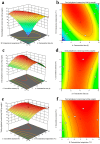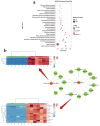Optimization of Liquid Fermentation of Acanthopanax senticosus Leaves and Its Non-Targeted Metabolomics Analysis
- PMID: 39407675
- PMCID: PMC11478309
- DOI: 10.3390/molecules29194749
Optimization of Liquid Fermentation of Acanthopanax senticosus Leaves and Its Non-Targeted Metabolomics Analysis
Abstract
To enhance the nutritional value of Acanthopanax senticosus leaves (AL), a fermentation process was conducted using a probiotic Bacillus mixture, and the changes in chemical constituents and biological activities before and after fermentation were compared. A response surface methodology was employed to optimize the liquid fermentation conditions of AL based on their influence on polyphenol content. Non-targeted metabolomics analysis was performed using LC-MS/MS to reveal the differing profiles of compounds before and after fermentation. The results indicated that Bacillus subtilis LK and Bacillus amyloliquefaciens M2 significantly influenced polyphenol content during fermentation. The optimal fermentation conditions were determined to be a fermentation time of 54 h, a temperature of 39.6 °C, and an inoculum size of 2.5% (v/v). In comparison to unfermented AL, the total polyphenol and flavonoid contents, as well as the free radical scavenging capacities measured by DPPH and ABTS assays, and the activities of β-glucosidase and endo-glucanase, were significantly increased. The non-targeted metabolomics analysis identified 1348 metabolites, of which 829 were classified as differential metabolites. A correlation analysis between the differential metabolites of polyphenols, flavonoids, and antioxidant activity revealed that 13 differential metabolites were positively correlated with antioxidant activity. Kyoto encyclopedia of genes and genomes (KEGG) enrichment analysis of the differential metabolites identified 82 pathways, with two of the top 25 metabolic pathways related to flavonoids. This study explores the potential for enhancing the active ingredients and biological effects of AL through probiotic fermentation using Bacillus strains.
Keywords: Acanthopanax senticosus leaves; complex probiotic; fermentation; non-targeted metabolomics.
Conflict of interest statement
The authors declare no conflicts of interest.
Figures













Similar articles
-
Untargeted Metabolomics Analysis of Lactic Acid Bacteria Fermented Acanthopanax senticosus with Regard to Regulated Gut Microbiota in Mice.Molecules. 2024 Aug 28;29(17):4074. doi: 10.3390/molecules29174074. Molecules. 2024. PMID: 39274922 Free PMC article.
-
Adsorption and Desorption Characteristics of Total Flavonoids from Acanthopanax senticosus on Macroporous Adsorption Resins.Molecules. 2021 Jul 8;26(14):4162. doi: 10.3390/molecules26144162. Molecules. 2021. PMID: 34299437 Free PMC article.
-
LC-ESI-MS/MS profiling of phenolics in the leaves of Eleutherococcus senticosus cultivated in the West Europe and anti-hyaluronidase and anti-acetylcholinestarase activities.Nat Prod Res. 2018 Feb;32(4):448-452. doi: 10.1080/14786419.2017.1308369. Epub 2017 Mar 28. Nat Prod Res. 2018. PMID: 28349704
-
Integrated Transcriptomic and Metabolomic Analyses Reveal the Effects of Grafting on Special Metabolites of Acanthopanax senticosus Leaves.Molecules. 2023 Jun 20;28(12):4877. doi: 10.3390/molecules28124877. Molecules. 2023. PMID: 37375432 Free PMC article.
-
LC-MS based metabolomics analysis of okara fermented by Bacillus subtilis DC-15: Insights into nutritional and functional profile.Food Chem. 2023 Jul 1;413:135656. doi: 10.1016/j.foodchem.2023.135656. Epub 2023 Feb 10. Food Chem. 2023. PMID: 36780856
Cited by
-
Eleutherococcus senticosus (Acanthopanax senticosus): An Important Adaptogenic Plant.Molecules. 2025 Jun 8;30(12):2512. doi: 10.3390/molecules30122512. Molecules. 2025. PMID: 40572479 Free PMC article. Review.
References
-
- Tohda C., Matsui M., Inada Y., Yang X., Kuboyama T., Kimbara Y., Watari H. Combined Treatment with Two Water Extracts of Eleutherococcus senticosus Leaf and Rhizome of Drynaria fortunei Enhances Cognitive Function: A Placebo-Controlled, Randomized, Double-Blind Study in Healthy Adults. Nutrients. 2020;12:303. doi: 10.3390/nu12020303. - DOI - PMC - PubMed
MeSH terms
Substances
Grants and funding
LinkOut - more resources
Full Text Sources

